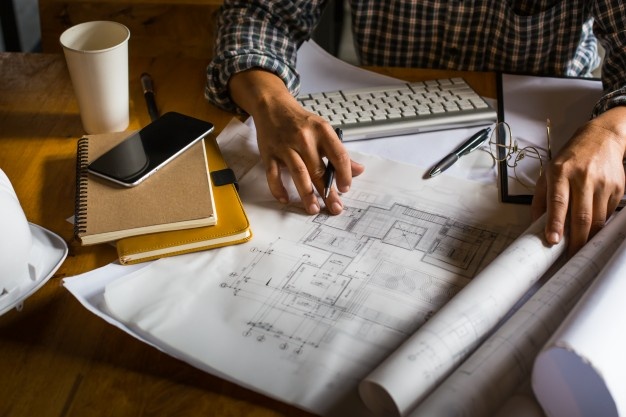You might get surprised that planning takes more time, way more time, than the construction itself. Some takes months, some even take years to complete the final plan. But the planning design and construction does not stop when the last brick is placed but it continues for so long. So, what is planning design and construction about? When does it start? When does it stop? How does the process work? Can I do it myself? Keep reading and we will tell you all about it!
EVERYTHING YOU NEED TO KNOW ABOUT PLANNING DESIGN AND CONSTRUCTION
PLANNING
Data collection and analysis, an understanding of who will occupy what space, how the space is utilized, and document management is all included in the planning phase. Basically, all documents related to a project such as documentation management that involves drawings, historic archived records of plans, and renovation works.
Aside from documentation, the other side of planning is more interactive. Programming, working to understand how the space was used previously, the current status of the space, and what the future plan is for the space are involved in the campus/facility planning. Programming, the foundation for the design effort, is essential to informing design aesthetics.
Planning is involved in data collection, with an inventory of each space being documented every three years, even after a project has been planned, sent off to construction, built and completed. Data collection of floor plans is on going because many changes that occur do not result in renovations.
DESIGN
Planners and designers develops programs and plans to meet the need of the client with close consultation with clients, contractors, architects and whoever is involved in the project. Projects can be as small as renovating an office or classroom or as large as a residential building. Often, these large-scale projects require the expertise of outside consultants.
After the schematic design, design developments, and construction documents phases are complete, the department oversees the construction and execution of the plans.
CONSTRUCTION
You should look for a company who is committed to provide modern and functional facilities or uses modern techniques and machinery in your project. They are responsible for the managing the development and execution of new construction and the renovations of existing spaces. There should be utmost dedication to ensure every structure remains functional, safe, and aesthetically pleasing.
HOW TO GET THE BEST PLANNING DESIGN AND CONSTRUCTION?
Residential construction companies Sydney is growing and offers project management services construction aside from the traditional planning design and construction. So, how do you choose the best company to work on your project? Here are some things you need to remember:
RECOMMENDATION
If you know other people, a family member or a relative or even a friend who have had recent residential building projects of their own, you could ask them whether they liked their builder and who it was. This is a sure way to finding out whether the builder was any good. People are likely to be honest with you because they do not want to lead a family or friend astray. This is what keeps people honest in recommendations. Therefore, these are often more reliable sources of information than online reviews. Personal recommendations have forever been a reliable source of finding quality in any service or product.
QUALIFICATIONS
We do not want someone to build you a safe space without any qualifications. Ensure that any builder you are looking at hiring has their license and is qualified to work as residential builders in Sydney. This is important because it shows that they are skilled enough to be licensed builder. You will want to hire someone with a license to build so you can be certain that this person or company has professionals and employees have studied a relevant qualification. This makes sure they are experienced and has no criminal record. This is a good start and an important reminder when choosing a builder.
EXPERIENCE
Finding a builder or a company who is experienced is the best way to protect your money and ensure that your house is in build safely. People who have been building day in and day out for years are less likely to make avoidable mistakes when working on your property. If they have been practicing for a long time, they will also have a history of clients that you can check out reviews from. Additionally, they may post some of their previous projects online so you can have a look at them and expect what they can deliver.
MAKE A BUDGET
Making out a budget is crucially important before embarking on any residential building expedition. This will inform the rest of the process. If you know how much money you must spend on the project, you can use that amount to make other important decisions along the way. Residential building companies Sydney or in general may depend on your budget and whether you have owned a home. For example, some builders specialize in building homes for the first-time buyers while others concentrate on mid-range projects, top-end custom-built designs and luxury projects for those with top-end budgets. Residential building designers Sydney would typically use as well as business model employed would prevent competitive pricing for a one-off build.
VERIFY THE COMPANIES FINACIAL STABILITY
A factor that causes residential builders to cut prices to maintain steady work is the markets extreme competitiveness. While this approach is good on paper it does not stand up over time. Businesses need to continually make money to be sustainable and cutting prices won’t result in a prosperous future. It won’t matter if the builder is not in business long enough to complete the project even if you may wind up with the best price around.
You can receive a credit resource from numerous online agencies to check on a particular company’s financial stability. Though this won’t guarantee you will get the best price and great results, it will prove to be one of the best financial indicators of a company’s strength and sustainability. Two items you should check for are whether the company pays suppliers on-time and its industry rating. These are good indicators of reliability.
LOCATION
Planning design and construction companies have specific areas where they offer the most competitive prices, so it is a good idea to select residential companies who have built several homes in the location where you want to live. It is easier to build in a metro area than it is outlying suburbs because everything is situated close together. You could incur additional costs and possible delays due to the lack of options available to the builder, so you want the builder you choose to be comfortable building in you proposed location.
If a company accepts your request to build out of a particular area, the price will include a contingency just in case it is needed. Since you won’t want this extra cost, it is advisable to find a residential builder who is well-represented in the area where you will build a new home.
Don’t Fall Prey to these 7 Common Planning Design and Construction Scams
In the planning design and construction industry, it is rather usual to commit fraud. That is not to suggest that the sector is riddled with dishonest individuals — rather, it is an industry in which the few deceitful individuals who are motivated to perpetrate fraud may have an easier time getting away with their crimes. This is largely due to the nature of the labor itself: a typical building project is a controlled chaos experiment of the highest order.
Funds have been diverted. Misuse of materials. Bills that have been cushioned. Cost overruns that aren’t visible. Construction companies lose money on a daily basis as a result of fraud committed by employees, contractors, subcontractors, and joint venture partners. But this isn’t simply a one-ended loss, but a much greater financial waste for homeowners and investors alike. And you wouldn’t want to get caught on these frauds, would you?
Thus, for a heads up, here’s 7 common planning design and construction scams you should not fall prey to.
1. Bogus Payment Applications
More than half of all planning design and construction scams are caused by fabricated pay applications. This type of application can be caused by a variety of factors, including incorrect totals or line items, roll-forward errors, erroneous invoices, or overstated rates in the backing invoices that do not accurately reflect the real expenses incurred. It is possible for planning design and construction professionals or project accountants to falsify pay applications in order to conceal the purchase of personal things or to channel money to a fictitious firm that they control.
Aside from wage rates and categories, other areas where fraud can occur include overhead and equipment rates, profit or markup formulas, and fee calculations. For example, a subcontractor billing for a manual laborer when an apprentice performed the work; incremental cost and equipment rates; and fee calculations. In order to prevent errors or anomalies from occurring, compensation applications from subcontractors must be constantly checked and inspected.
2. Changing the Course of Business and Misappropriating Equipment and Tools
Take steps to ensure that the supplies and materials you pay for are indeed used on your job sites and not for a subcontractor’s individual project or for the personal use of an employee or a subcontractor. Items purchased and sent to a separate project site, as well as acquisitions of tools and machinery that appear to be in surplus of project criteria, should be on the lookout.
3. Misleading Representations
Many planning design and construction contracts contain precise provisions regarding the subcontractor’s workers, insurance, procurement, and other aspects of the subcontractor’s business. For example, a contract may include that all subcontractors must employ a certain number of minority labor or residents of the city in question. Keep an eye out for subcontractors who make false representations about their work. When subcontractors make misleading statements about their work, the contractor is frequently held liable, particularly when the work involves minorities or poor quality.
4. Bid Suppression
In general, bid suppression is self-explanatory – it occurs when candidates are intimidated, bribed, or otherwise persuaded not to submit a bid on a specific task. It could be accomplished through large payouts, mutual consent, or even with the threat of force or some other action on their part
5. Switching the Focus of Lump-Sum Costs to Time and Materials Costs
Avoid expenses that are estimated in a solid mass amount but are subsequently invoiced by the subcontractor for the time and materials associated with these services after they have been completed. For example, is the subcontractor charging time and materials for the rental cost of an industrial vacuum when a lump sum payment in the financial plan should already finance the purchase of the industrial vacuum?
6. Bidding in a Complementary Manner
While complimentary bidding is similar to bid suppression, it differs in that competitors predetermine who will succeed the bid. The other bidders would submit unreasonably high offers or proposals with undesirable additional terms in order to give the impression that there is real competition in the bidding for the contract.
7. Falsified Timetable of Values and Contingency Accounts
Failure to modify Schedule of Values (SOV) line items as layoffs or adjustments are made might create a chance for fraud to be concealed and covered up. For instance, a planning design and construction manager or project bookkeeper might cover up buyout savings by including a provision in the SOV that allows hoax bills obtained from offshore accounts (companies that do not have self-governing assets or operational processes of their own, but are used merely to undertake particular business transactions) under their regulation to be charged to the project’s savings.
Alternatively, if the savings is hidden away in the SOV line, a shady project coordinator or project bookkeeper can apply bogus bills against the buyout savings sum, and the building company’s higher ups will not be able to detect this charge by comparing budgeted performance to actual performance, as is the case with most construction companies. Similarly, subcontractors that charge material or supplies on a pass-through approach can use this strategy to save money on their costs.

These planning design and construction scams are a real horror especially if you’re standing a tightrope of financial resources. Thus, choosing the most credible among you residential building designers Sydney is an imperative decision one must not simply overlook. Thus, choosing Criss Cross Constructions will definitely work in your favor. We are a building construction company Sydney that is big enough to meet our customer’s needs, small enough to be hands-on. We have the experience, the references, the competitive pricing and the desire to bring the customer the dream building project they desire.
WHY CHOOSE CRISSCROSS CONSTRUCTION?
With more than 25 years of collective experience within the planning design and construction company Sydney industry, it has allowed us the opportunity to find and build relationships with key suppliers, consultants and subcontractors who share our philosophy and therefore enable us to deliver great value to our clients. If you have any questions, you can explore our official website or contact us and set a meeting to address your questions and have them answered directly.
Get a quote for our planning and design services by filling out the form below:


